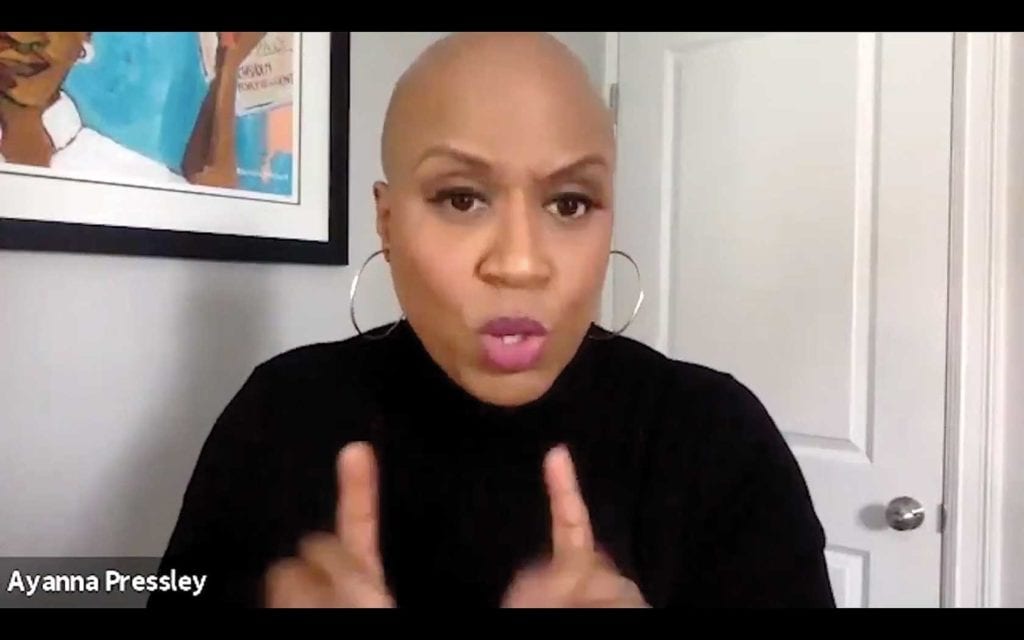
The U.S. Census is still weeks away from releasing data on population changes, but Massachusetts elected officials and political activists are already knee-deep in the redistricting process as the Legislature prepares to redraw political boundaries to respond to shifts in the state population.
On Monday, Congresswoman Ayanna Pressley weighed in as the Legislature’s Special Joint Committee on Redistricting heard testimony on the 7th Congressional District she represents in the House.
When that district was re-drawn during the 2010 redistricting process, it became a so-called majority-minority seat, one in which Blacks, Latinos, Asians and other people of color outnumber the whites who make up the majority population of Massachusetts.
Pressley advocated for the district remaining majority people of color.
“I am confident that using the same principles top-of-mind when these boundaries were drawn 10 years ago, centering the racial and economic diversity of the Massachusetts 7th as its strength and keeping municipalities whole when possible will guide these difficult conversations and even more difficult decisions.”
The population in Massachusetts increased by 5.3% from the 2010 U.S. Census to the 2019 Census American Community Survey estimate. Had the population not increased at a rate close to the 5.9% rate of population increase nationwide, Massachusetts may have lost a congressional seat.
But within Massachusetts, population changes across town and neighborhood lines are more variable.
Boston, for instance, in the middle of its greatest population surge in decades, saw its population increase from 617,594 to 692,600. That increase of more than 75,000 people gave Boston a 12% bump in its population, far more than the 2.2% increase in population in Milton, which gained 590 new residents, bringing its total to 27,593.
Randolph saw its population increase by 2,250, to 34,362 — a 7% increase.
Largely because of the greater-than-average population increase in Boston, the 7th Congressional District may need to be reconfigured to shed as many as 53,000 people in order to stay proportionate with other Massachusetts districts. Because the district reaches through Milton into Randolph, Milton precincts cannot be shed from the district without losing all of Randolph, a majority people-of-color town.
The district could also shed precincts in Cambridge, Somerville or Chelsea. But some residents from those cities testified against being dropped from the district, as did numerous Randolph residents, including Town Manager Brian Howard.
“You have the opportunity to keep both a community of interest and to keep a community whole,” he said.
In the redistricting process, a “community of interest” can be a geographic area with a strong identity or a group or groups of people with common interest within a district.
Others who testified argued for greater cohesion in the northern reaches of the 7th Congressional District, called on lawmakers to stay in the 7th District. Chelsea School Committee member Roberto Jiménez argued his city’s majority Latino population belongs in Pressley’s majority-people-of-color district.
“It would not make sense to me if we were not kept in that district,” he said.
Beth Huang of the Drawing Democracy Coalition said that the majority-Latino populations of Chelsea, East Boston and Revere suffer from lack of adequate representation, as they are divided among majority-white House districts.
“A top priority for the Drawing Democracy Coalition is reconfiguring the districts in East Boston and the municipalities just north of Boston,” she said. “Population growth in East Boston, Chelsea and Revere necessitates change, and recent primary elections have suggested that BIPOC voters in the more working-class side of the district cannot send a candidate of their choice to the State House.”
Huang argued that working-class communities are politically marginalized when they are represented by people who live in wealthier communities.
“Although the elected official and their staff may make many efforts to serve the entire district, they naturally spend more time in the part of the district where they live, likely get more votes from the wealthier area, and more campaign contributions come from their side of the district,” she said.
Rep. Michael Moran said the Legislature will take a close look at the Latino-majority area.
“We’ll be looking at that district to see what the last 10 years have given us,” he said.
In addition to advocating for a Latino-majority district north of the city, Huang urged the legislature to create a third majority-minority state Senate seat in the area. Currently, the 1st Suffolk District represented by Sen. Nick Collins and the 2nd Suffolk District represented by Sen. Sonia Chang-Diaz are majority people of color.
“Although we do not have the census data yet, population estimates suggest that drawing a third majority-BIPOC state Senate district is possible,” she said. “Assuming that the census data bears out this assumption, drawing a third majority-BIPOC district is a top priority for the Drawing Democracy Coalition.”
Last week’s hearing was the eighth held by the Redistricting Committee. The U.S. Census data that committee members will rely on to draw the new districts is expected to be released in August.







